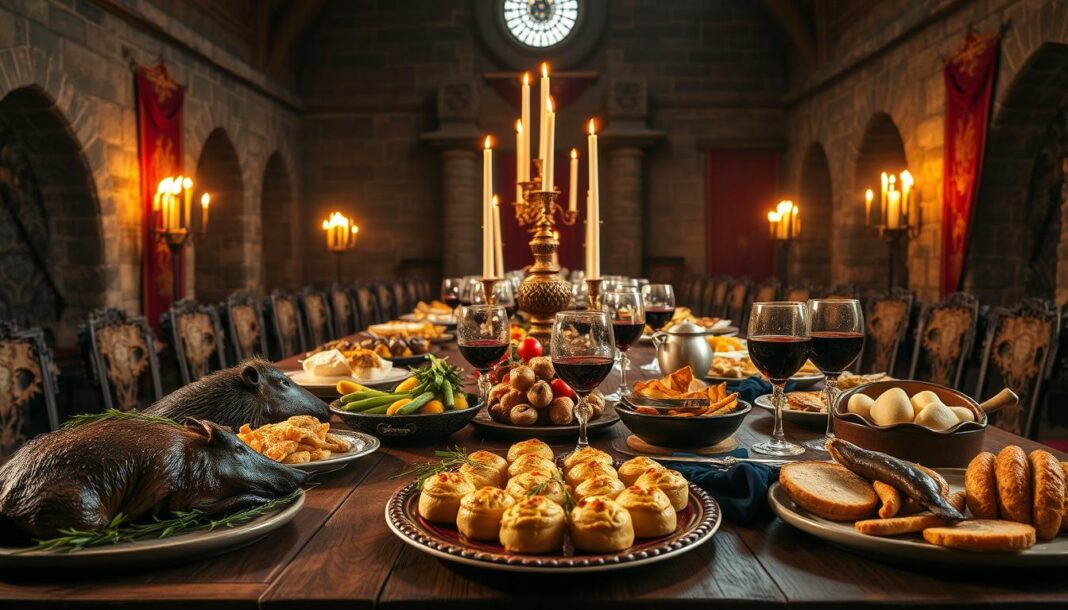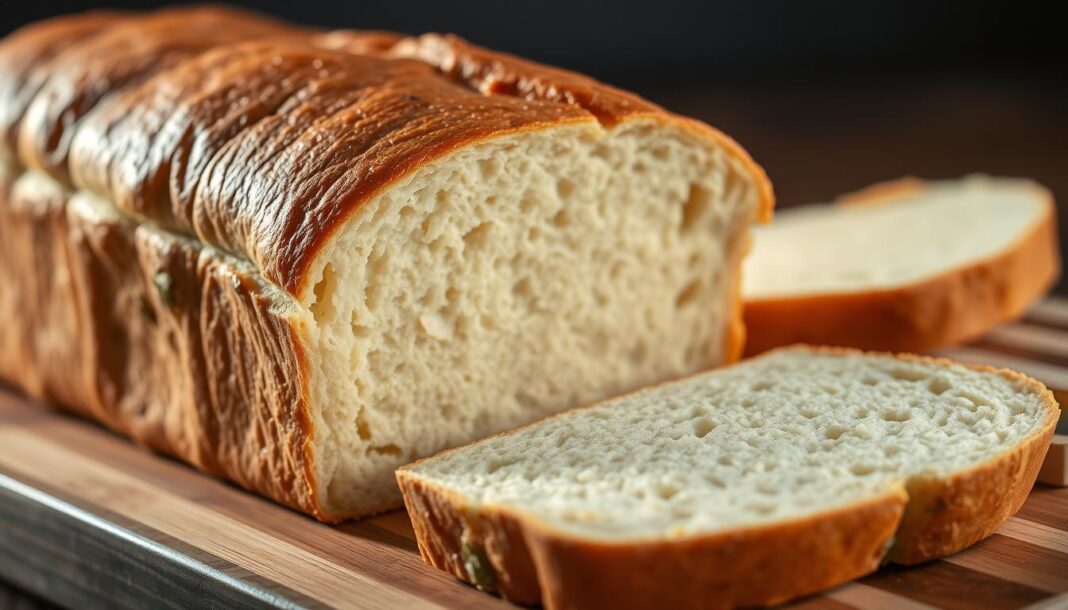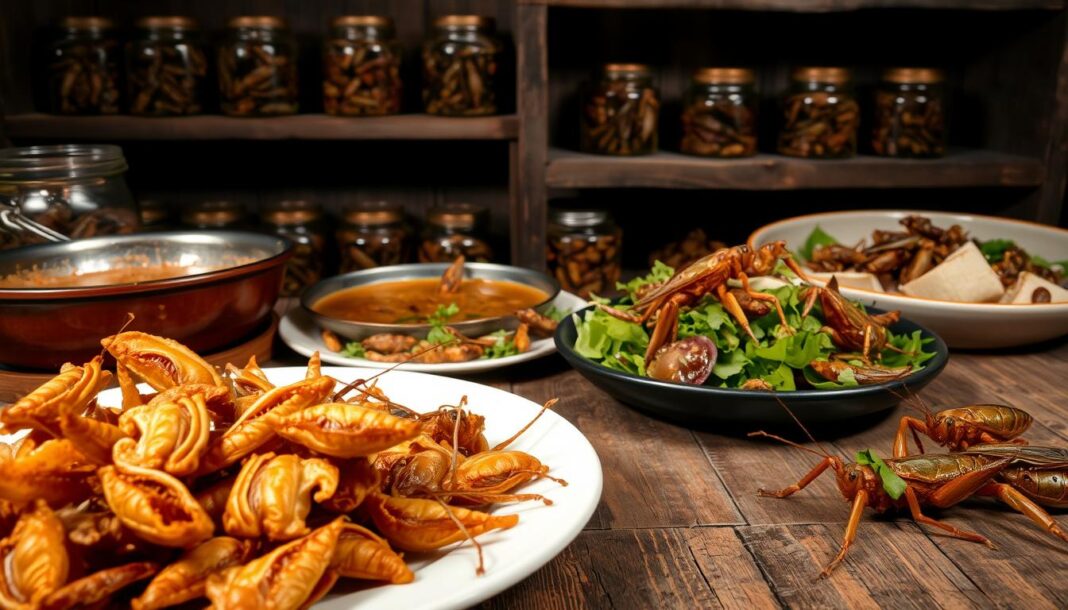As we embark on this culinary journey through the world of Game of Thrones, we explore how food plays a pivotal role in the series, serving not just as sustenance but as a storytelling device.
The diverse cuisines across the Seven Kingdoms reflect the cultural differences between regions, from hearty stews to exotic spices.
We analyze how the show‘s creators used historically-inspired medieval dishes to enhance the fantasy world’s authenticity. For more on this, visit our collection of Game of Thrones recipes.
Key Takeaways
- The role of food in Game of Thrones as a narrative device.
- Culinary diversity across the Seven Kingdoms.
- The use of historically-inspired dishes in the show.
- Symbolism of food in power dynamics.
- Iconic foods mentioned in the books and show.
The Culinary World of the Seven Kingdoms
As we explore the culinary world of Game of Thrones, we find that dishes and meal times are deeply rooted in the culture of the Seven Kingdoms. The medieval period’s influence is evident in the hearty meat stews consumed by the poor, made with available ingredients ranging from vegetables to discarded meat cuts.

The culinary traditions across the Seven Kingdoms mirror those of medieval Europe, with distinct regional variations reflecting geography and climate. For instance, the contrast between noble feasts and peasant meals serves as a powerful storytelling device, highlighting class divisions.
- Food preparation and preservation techniques in Westeros closely resemble medieval methods, with smoking, salting, and pickling being essential for winter survival.
- The importance of seasonal eating is emphasized throughout the series, with characters preparing for winter by storing root vegetables and preserved meats.
- Mealtime rituals and dishes in the show reflect the cultural values and social hierarchies of each region in this fantasy world.
By examining these culinary practices, we gain insight into the social and cultural fabric of Westeros, where meal times are not just about sustenance but also about community and status.
Feasts Fit for Kings and Queens
In the world of Game of Thrones, feasts fit for kings and queens are not just about food, but about politics and power plays. These elaborate events serve as a backdrop for crucial decisions, alliances, and conflicts.
Royal Banquets and Their Significance
Royal banquets in the show often featured symbolic foods representing alliances, with dishes from various regions signifying political connections. The extravagance of these feasts contrasted sharply with the food shortages experienced by common folk.
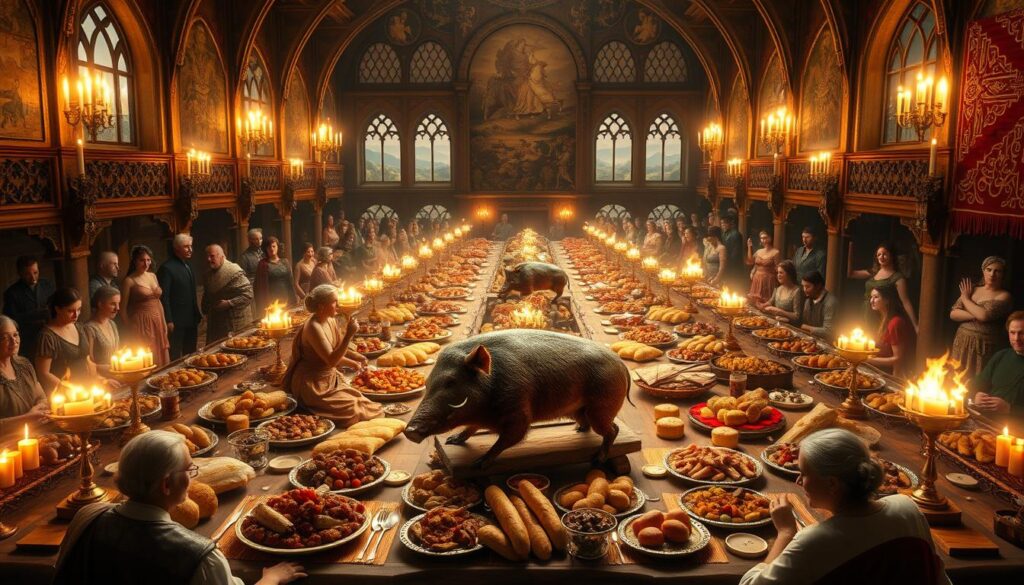
The Infamous Purple Wedding Feast
The Purple Wedding feast in Season 4 stands as perhaps the most memorable banquet in the series, featuring dozens of dishes served across multiple courses at King’s Landing. The pie filled with live pigeons, which Joffrey sliced open, remains a shocking moment.
- We’ll analyze the elaborate royal feasts depicted in Game of Thrones.
- The Purple Wedding feast featured symbolic foods and represented a stark contrast to the struggles of the common people.
Lemon Cakes: Sansa Stark’s Favorite Delicacy

The delicate flavor of lemon cakes resonates with Sansa Stark’s longing for the luxuries of the nobility. These desserts symbolize luxury in Westeros, as lemons were imported from warmer southern regions, making them expensive and available only to the wealthy. We examine how lemon cakes became synonymous with Sansa Stark’s character, representing her refined tastes and aspirations for a courtly life.
We’ll share a historically-inspired recipe for recreating these iconic cakes, balancing authenticity with modern ingredients. This treat, significant to Sansa’s journey, represents her maintaining a piece of her original identity amidst turmoil.
Bowls of Brown: The Staple of Flea Bottom
In the slums of King’s Landing, a notorious stew known as “bowls of brown” was a grim reality for the poor. This unappetizing dish was a staple in Flea Bottom, made from a mixture of whatever ingredients were available at the time.
The Mysterious Ingredients
The composition of “bowls of brown” was as unpredictable as it was unpalatable. The stew could contain anything from pigeons to rats, making it a culinary gamble for those who consumed it. The meat used in the stew was often questionable, and the cooking process did little to mask the dubious nature of the ingredients.
Medieval Comparison: Pottage
The concept of “bowls of brown” bears a striking resemblance to medieval pottage, a stew made from a variety of ingredients including meats, vegetables, and oats. This historical parallel highlights the universality of poverty and the resourcefulness of those who had to make do with limited culinary resources.
To better understand the similarities between “bowls of brown” and medieval pottage, let’s examine the following comparison:
| Characteristics | Bowls of Brown | Medieval Pottage |
|---|---|---|
| Main Ingredients | Variable – pigeons, rats, cats | Variable – meats, veggies, oats |
| Cooking Method | Simmered in pots, rarely emptied | Simmered, ingredients added over time |
| Social Context | Flea Bottom, King’s Landing | Poor European households |
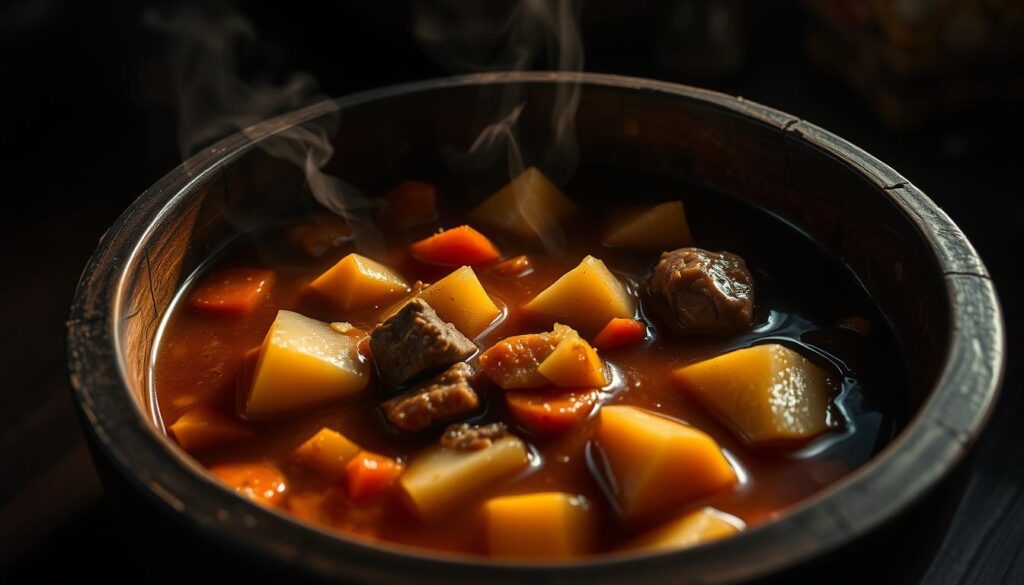
The table above illustrates the similarities between “bowls of brown” and medieval pottage, both in terms of their ingredients and cooking methods, as well as their social context. Both dishes were staples among the poor, reflecting the harsh realities of life in impoverished conditions.
Hot Pie’s Direwolf Bread: Baking as an Art Form
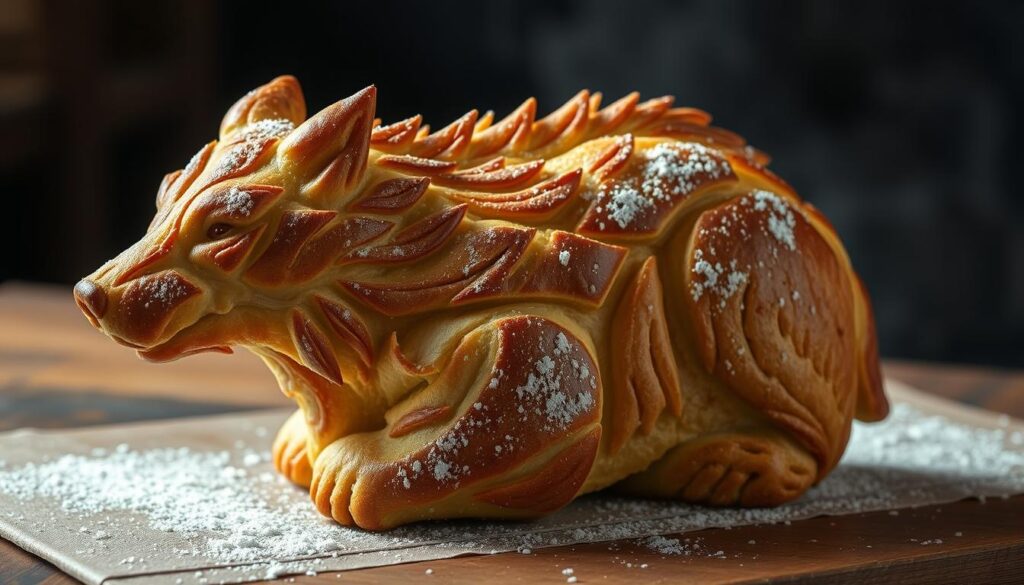
Hot Pie’s direwolf bread is a heartwarming symbol of friendship in the harsh world of Game of Thrones. As a baker’s apprentice, Hot Pie’s skills evolve significantly, reflecting his growth and dedication. We examine how his improving bread-making skills symbolize his character development, from early attempts to his masterful direwolf bread.
The direwolf bread represents one of the few purely heartwarming moments in Game of Thrones, showcasing friendship and loyalty. We’ll provide a simple recipe for recreating Hot Pie’s signature direwolf bread, using basic ingredients and techniques for achieving the detailed wolf shape.
Pigeon Pie: A Westeros Tradition
The tradition of pigeon pie in Westeros is a fascinating blend of everyday cuisine and ceremonial feasting. In the Seven Kingdoms, both the upper and lower classes enjoy pigeon pie, reflecting its versatility and widespread appeal.
Wedding Pies vs. Everyday Pies
While smaller pigeon pies are served at regular dinners, larger, more elaborate versions are reserved for special occasions like weddings. The infamous wedding pie at Joffrey’s celebration, filled with live pigeons, exemplifies the dramatic flair of ceremonial pies.
Historical Context of Bird Pies
The use of pigeon meat in pies has historical roots in medieval cuisine, where birds were a common ingredient. The thick crust of these pies, sometimes more akin to bread trenchers than a delicate pastry, served as a container for the filling, highlighting the resourcefulness of medieval cooking techniques, often used during a special season.
Pigeon pie remains a significant dish in Westeros, symbolizing the blend of mundane and spectacular culinary practices, with the pie being a centerpiece.
The Night’s Watch Diet: Surviving at Castle Black
The harsh realities of life at Castle Black are reflected in the Night’s Watch diet, where rancid stews and stale bread were staples. The brothers of the Night’s Watch, including Jon Snow, often had to subsist on meals that were less than appetizing.
Rancid Stews and Stale Bread
The stews served at Castle Black were made with cheap and often rancid meat, accompanied by stale bread. This diet was a reflection of the limited resources available to the Night’s Watch.
The Importance of Preserved Foods
Preserved foods played a crucial role in sustaining the brothers during harsh northern winters. The diet included:
- Stale bread
- Rancid meat stews
- Preserved foods to supplement their meager supplies
This harsh diet was a constant reminder of the sacrifices made by those who took the black, giving up comfort and their former identities to serve at the Wall.
Dothraki Cuisine: Horse Heart and Beyond
The Dothraki people, known for their horsemanship and nomadic lifestyle, have a unique cuisine that revolves around horse meat. In the world of Game of Thrones, their diet is a reflection of their cultural values and traditions.
The Dothraki diet includes various preparations of horse meat, such as roasted flesh served with honey and peppers. They also consume fruits, pastries, and sweetgrass stews as side dishes. Additionally, they ferment and drink mare’s milk, showcasing their resourcefulness in utilizing horse products.
The Raw Heart Ritual
One of the most memorable meal scenes in Game of Thrones is Daenerys consuming a raw horse heart. This act symbolizes her adoption of Dothraki culture and is rooted in their legend, which states that if a pregnant Khaleesi can eat and keep down a raw heart, her son will be strong.
Everyday Dothraki Meals
Everyday Dothraki meals are practical yet flavorful, often prepared over an open fire during their migrations. Their cuisine is characterized by portable foods that can be easily cooked, reflecting their nomadic lifestyle. While medieval European cuisine rarely included horse meat after Christianization, the Dothraki diet resembles that of historical nomadic steppe peoples.
Northern Delicacies: Winterfell’s Hearty Fare
In the North, where winters are harsh and long, the cuisine is as rugged as the landscape, featuring dishes like kidney pies and hearty stews. The Stark family’s culinary traditions are deeply rooted in their history and the harsh climate of the North.
Kidney Pies and Meat Stews
The kidney pie, a favorite of the Stark children, is made with peas and onions, as reminisced by Jon and Sansa during their reunion at Winterfell. According to Hot Pie, the key to a good kidney pie lies in its ingredients, particularly the cow’s kidney. This traditional dish reflects the practical nature of Northern cuisine, emphasizing preservation and hearty ingredients.
Root Vegetables and Preserves
Root vegetables such as turnips, carrots, and potatoes form the backbone of Northern cooking. These hardy crops are stored in Winterfell’s extensive cellars, providing sustenance through the long winter months. The use of preserved foods is crucial, with methods like pickling and smoking being essential survival skills.
| Dish | Main Ingredients | Significance |
|---|---|---|
| Kidney Pie | Cow’s kidney, peas, onions | Family tradition, hearty |
| Meat Stew | Various meats, root vegetables | Warming, nourishing |
| Root Vegetables | Turnips, carrots, potatoes | Stored for winter, versatile |
The cuisine of the North, as seen in Winterfell’s kitchens, is a testament to the resourcefulness and resilience of its people. By focusing on preservation and hearty, warming dishes, the Northern delicacies stand out as a unique and flavorful aspect of the Game of Thrones culinary world.
Cersei’s Wine: The Finest Vintages in Game of Thrones Foods

Wine plays a significant role in Cersei’s life, serving as both a luxury and a coping mechanism. We examine Cersei Lannister’s infamous relationship with wine, which serves as both character development and a coping mechanism throughout her tumultuous rule in King’s Landing. The finest vintages in the game of power were imported from regions like the Arbor.
Cersei’s preference for red wine symbolizes both her Lannister heritage and the bloodshed she causes. Wine consumption in the series reflects social status, with the quality and quantity of wine served indicating wealth and power.
Sweet Treats Across the Realm
From the honey-soaked cakes of the Reach to the lemon-infused desserts of Dorne, sweet treats varied across Westeros. The use of honey as a primary sweetener in Westerosi desserts accurately reflects medieval culinary practices, where refined sugar was a luxury.
Honey Cakes and Candied Plums
Honey cakes, briefly mentioned in A Game of Thrones, were a staple dessert. These cakes, soaked in honey, were a simpler alternative to sugar-based desserts. Candied fruits like plums were luxury items, often used as gifts or bribes, as seen when Qyburn uses them to win over Varys’s “little birds.”
Desserts for Different Classes
Dessert consumption varied significantly by social class. While nobles enjoyed elaborate confections, commoners savored simple honey cakes on special occasions. The techniques used for these sweet treats often involved preservation methods, allowing fruits to be enjoyed out of season.
| Dessert Type | Social Class | Region |
|---|---|---|
| Honey Cakes | Commoners | Reach |
| Candied Plums | Nobles | King’s Landing |
| Lemon-infused Desserts | Nobles | Dorne |
The variety of sweet treats in Westeros not only reflected the region’s culinary diversity but also its social hierarchy. As we explore these desserts, we gain insight into the culture and traditions of the Seven Kingdoms.
Feast of the Hands: Foods Named After Characters
The art of naming dishes after famous characters is a playful tradition in Westeros, reflecting the rich culinary culture of the Seven Kingdoms. This creative expression allows fans to connect with the series on a deeper level, exploring the intersection of food and character.
The Onion Knight’s Signature Dish
Ser Davos Seaworth, known as the Onion Knight, has a dish named after him, reflecting his humble beginnings as a smuggler of onions to King’s Landing. A simple yet flavorful onion recipe can be a great way to pay homage to this beloved character. We can recreate this dish by sautéing onions with a bit of olive oil and seasoning, serving them alongside a hearty roast.
The Mountain’s Smashed Potatoes
“The Mountain,” Gregor Clegane, is infamous for his brutal strength, and his namesake dish reflects this trait. Smashed potatoes are a simple, comforting food that can be made by boiling potatoes until tender, then smashing them with a fork and mixing in butter, salt, and pepper. For an added twist, we can incorporate some spicy chicken or a side of roasted vegetables.
The thing about these character-named foods is that they serve as a fun way for fans to engage with the series, bringing the fantasy world into real-life kitchens through creative recipes and culinary experiences.
Medieval Reality vs. Westeros Fantasy
As we explore the culinary world of Westeros, it’s essential to distinguish between historical accuracy and creative liberties taken in the Game of Thrones series. The show often blends medieval reality with fantasy elements to create an immersive experience.
Many staple foods depicted in the series, like pork pies, bread, and stews, accurately reflect what people ate during medieval times. However, the show occasionally introduces anachronistic elements, such as certain spices or preparation methods that wouldn’t have been available in a true medieval setting.
Historical Accuracy in Game of Thrones Foods
The production team balanced historical accuracy with visual appeal, creating food scenes that looked appetizing on screen while maintaining period authenticity.
Creative Liberties in the Show
The depiction of regional food differences in Westeros mirrors the real variations in medieval European cuisine, with northern regions favoring hearty, preserved foods while southern areas enjoyed fresher ingredients and more spices.
Recreating the Tastes of Westeros at Home
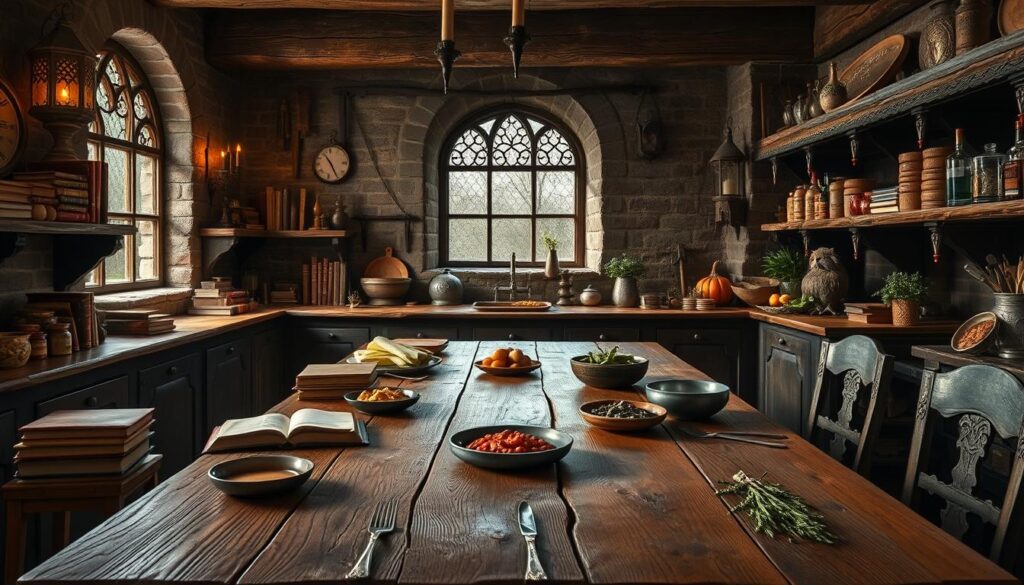
Recreating the flavors of Westeros in your own kitchen is easier than you think, with a collection of Game of Thrones-inspired recipes. We’ve curated a list of dishes that bring the fantasy world to life, from simple bread and chicken dishes to elaborate feast centerpieces. Modern adaptations of Westerosi recipes often substitute more accessible ingredients while maintaining the spirit of the original dishes.
Using honey as a primary sweetener and incorporating herbs and spices available in Westeros, you can capture medieval flavors. These dishes allow fans to experience the series in a new sensory dimension, bringing the tastes of Winterfell and King’s Landing to their own dining tables.
Conclusion: A Feast of Ice and Fire
As we conclude our culinary journey through Westeros, it’s clear that food played a pivotal role in the Game of Thrones saga. We’ve explored how wine and other beverages were integral to the series, from Cersei’s favorite drink to ceremonial toasts. The diverse culinary landscape, from the humble bread of Flea Bottom to lavish feasts in King’s Landing, reflected the themes of power, class, and cultural identity.
Our journey has inspired many to recreate these dishes, with fans using various recipes to bring Westeros to their tables. The attention to detail in the show’s food scenes has not only enhanced the narrative but also spawned a community of enthusiasts eager to explore the culinary world of Game of Thrones.
